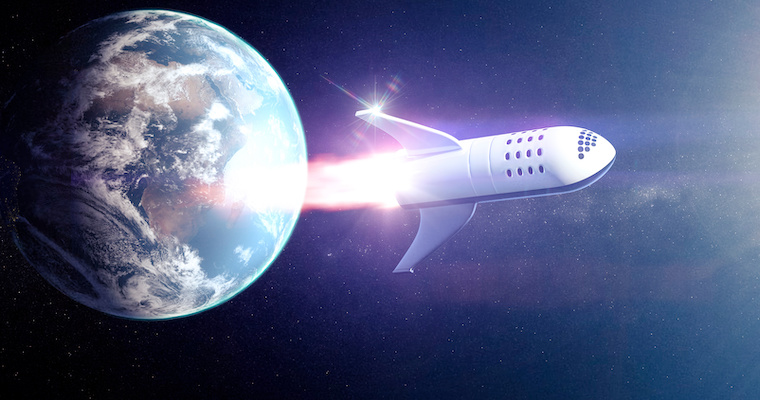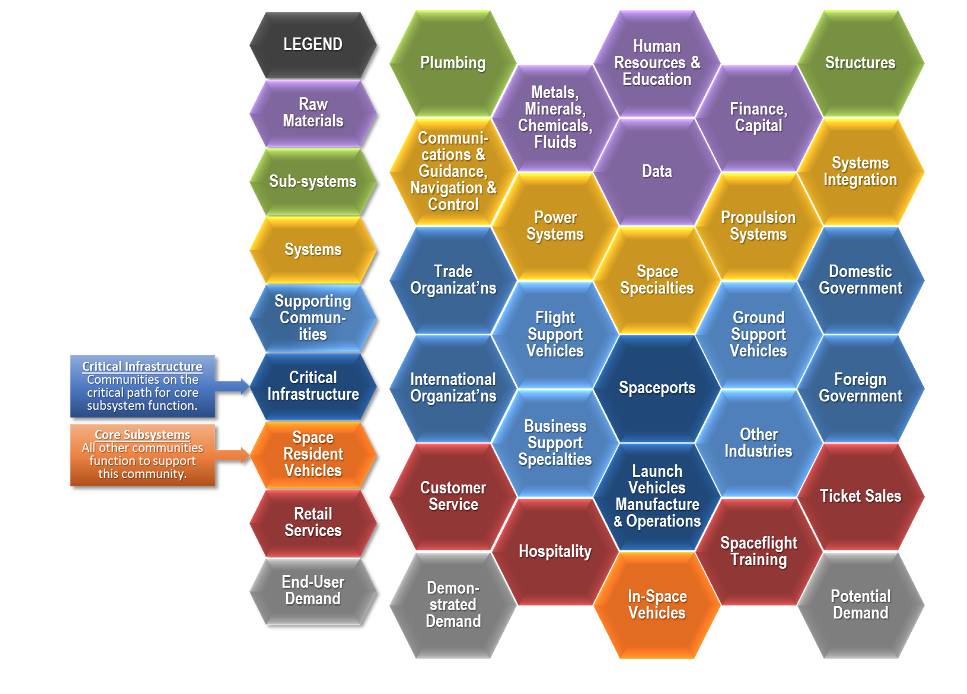To the Stars! The Present Challenges and Future Possibilities of Space Entrepreneurship

In recent years, the emergence and growth of startups in the space sector transformed activities that used to be the sole purview of government entities and large aerospace companies into opportunities for commercial entrepreneurship. Fueled in part by the audacious successes of SpaceX to re-use rocket boosters, and other commercial innovations developed by private ventures, the costs of launching orbital vehicles declined from $51,000/kg in the early 1980s for the Space Shuttle to an estimated $200/kg for SpaceX’s Starship (Venditti, 2022).
The ambitions of SpaceX and other spacefaring ventures, however, extend beyond improving the economics of near-earth spaceflight. By 2023, SpaceX plans to complete an orbital transit around the moon with Starship, and by 2026, the company plans to send humans aboard Starship to Mars. SpaceX’s recent success and ambitious future plans alongside of other space ventures including Blue Origin, Virgin Galactic, Terran Orbital, Sierra Space, Planet Labs, among many others fueled more than $250B in global private investment in space ventures over the past decade (Space Capital, 2022). The growth of private space companies promises to transform the future of space exploration and travel. The purpose of this article is to explore these trends, and to highlight the present challenges and future possibilities of space entrepreneurship.
Historical Overview
The early history of space activities began in the early 1900s and by mid-century national governments began developing industrial base space capabilities primarily driven by geopolitical goals and wartime imperatives. So strong was the sense of competition in 1962, particularly to project “soft power” through technological achievements, that it took less than seven years for one of the two major global superpowers to successfully fly humans to the moon and return them safely to Earth. This feat was so difficult and futuristic that it has not been accomplished again in the 50+ years since.
Later in the late 20th century, the need for economic development stimulated the creation of new government-led space programs and activities, developing their citizen workforce via technological specialization and advancement. Almost without exception, space programs were perceived as the domains of nation-states, and countries approached the formation of a space industrial activities along market orientations of a monopsony (where there are multiple suppliers and the state is the only buyer) or state-owned-enterprises (where the state is the only supplier and buyer). At the same time, a different type of market emerged in the industry segment of satellite communications. In the 1970s, the first international quasi-corporations formed to operate large telecommunications satellite systems within closely legislated and regulated “mercantile” markets. Other space industry segments during this period remained within the domain of governmental activities.
Over the past two decades, trends of electronics miniaturization and low-cost manufacturing of high-quality components unleashed a wave of innovation in space capabilities, and the result is a dramatic increase in the creation of new space companies. Although many of these new firms primarily support governmental goals in exchange for government support, the remaining firms are sources for commercial market emergence in both pre-existing and novel space industry segments, including launch vehicles for small payloads (less than 500kg), heavy lift launch vehicles, suborbital and orbital tourism, on-orbit capsules, and space stations. Private capital support and independent goal-setting are distinguishing factors of the “new space” actors from government-serving actors.
The Space Entrepreneurship Industry Today
Commercial space discussions often characterize it as a single entity. At a minimum, commercial space is one of many market arrangements within the overall space sector, which includes three distinct communities (also referred to as “industries”), each containing multiple populations (also referred to as “industry segments”). The three primary space sector communities include one core subsystem community (In-Space Vehicles) and two complementary communities (Spaceports and Launch Vehicles). Each of these communities encompass multiple populations.
Surrounding the core subsystems and their complementarities, multiple production-side (aka “upstream”) communities are grouped into categories of supporting capabilities, systems, sub-systems and raw materials. Community groupings on the distribution-side (or “downstream”) are categorized as retail services and end-use demand. Figure 1 shows these community groupings (distinguished by color) each containing one or more member communities (depicted as hexagonal cells) graphically clustered around the three primary “space sector” communities.

Figure 1. Graphic depiction of space sector communities.
A discussion of each community in the space sector is beyond the scope of this article, but below we describe the three primary space sector communities: in-space vehicles and its two complementary communities, spaceports and launch vehicles.
In-Space Vehicles
In-space vehicles include orbital or suborbital capsules and space planes capable of carrying humans that achieve an altitude of approximately 80-100km (50-60 miles), orbital capsules capable of carrying humans, satellites of any kind (e.g., satellite servicing, communications, or observation – either of the Earth or astronomical, and in any wavelength or wave band), or habitats (e.g., international space station modules). Potential future in-space vehicles include orbital transfer vehicles, solar power satellites and fuel depots.
Spaceports
Facilities, equipment, and capabilities used by vehicle systems to launch, take-off, or return from flight missions are commonly referred to as spaceports. Core spaceport technologies distinguish vertical launch from horizontal take-off/launch facilities. Authority relations and market strategies of spaceports vary primarily based on customer bases of government, single, or multiple users. Many multi-user facilities currently exist that conduct activities other than launches (e.g., training, component testing, etc.). As of early 2022, there are a large number of active, inactive, and planned spaceports around the world. Active spaceports tend to be federal ranges serving both governmental and non-governmental customers. Many of the inactive spaceports are supported by governments at the local or state levels.
Launch Vehicles
The traditional definition of a launch vehicle is based on the conversion of potential energy stored in chemical propellants (fuels and oxidizers, either liquid and/or solid, sometimes combined into a single molecule referred to as hypergolic) into kinetic energy through the mechanism of controlled combustion and expansion through a convergent-divergent nozzle. This description fits almost every launch vehicle in operation to date (although some launch systems include an air-breathing aircraft as a “first stage”) and some other designs do not use chemical propellants. Other prominent design architectures include multi-stage cylindrical configurations, launch at altitude by being dropped from underneath a carrier aircraft, and the return of a capsule (with or without humans) via parachute or via a glide or powered landing on a runway. Some launch vehicles are designed to reach Earth orbit (attaining a speed of approximately 17,000 miles per hour, or Mach 24) while others do not (suborbital vehicles only typically reach a speed of Mach 3). Some orbital launch vehicles are designed to carry massive payloads (large volumes and mass from 6-10 tons), some to carry humans (requiring higher levels of redundancy and safety), and others to carry smaller payloads (with smaller volumes and less than 500 kg in mass).
Key Challenges in Space Entrepreneurship
The current growth in private investment and public interest in space entrepreneurship presents an array of present-day challenges and future possibilities for aspiring space entrepreneurs. In this section, we highlight several important present and future trends that will likely shape the emergence of this sector:
Private Investment in Space Ventures is Rapidly Growing But Remains Highly Concentrated: Over the past decade, private investment in space ventures has surpassed $250B, clustered mainly in late-stage investments in ventures based in the U.S. and China. In recent years, the frequency of early-stage investments in space ventures has continued to grow and diversify across geographical locations but remains concentrated in ventures that build rockets and satellites, often for governmental entities. Both sector-specific and geographic concentration of space ventures potentially help grow local space ecosystems, but questions arise about how these trends might limit the growth of nascent space entrepreneurship activities in other sectors.
Prohibitive Costs of Personal Space Travel: Several segments of the core space sector communities are dynamically changing and growing to serve commercial markets, including heavy lift launch vehicles, small launch vehicles, small satellites, suborbital tourism, and orbital tourism. Orbital Assembly, Axiom Space and Orion Span are all planning to build "space hotels" soon, with plans to welcome their first guests by 2027, but the cost of these trips is still prohibitively expensive for most people around the world.
Lack of Commercial Space Ventures Legitimacy: The social acceptance and legitimacy of space operations by private organizations is still relatively low for endeavors that are non-scientific, non-military and non-political in nature. For example, when the general societal awareness of space tourism (both orbital and suborbital) rises above insignificant levels, it is commonly perceived as a symbol of inequality or injustice (i.e., an activity only for rich). The fear is that private companies will profit directly and substantially from the direct support and subsidies provided by the U.S. government without returning any profits to the public sector. However, the initial high cost of private space services demonstrates the same characteristics of many new industries of luxury goods considered to be “privileges” instead of “rights” (e.g., the automobile).
Lack of Demand: A major challenge facing space industry entrepreneurs is the lack of significant numbers and levels of non-governmental demand. Central governmental agencies directed the space industry markets during the 1960s and 1970s, characterized as a “teleologic” change motor. Competition drives commercial markets in the “evolution” change motor and one of the three primary characteristics of commercial markets, the retention force, is minimal in governmentally-driven space activities. The space market can be called "commercial" only when a significant number of independent customers represent a significant level of demand (in terms of sales revenue). For example, both Blue Origin and Virgin Galactic publicly announced having more than 600 reservations from customers, representing a potential revenue of approximately $100 million. To date, SpaceX flew two orbital flights with non-governmental “spaceflight participants” on board and has reservations for at least 5-6 more. A major challenge for space industry entrepreneurs is having an innovation product with sufficient private and/or public financing but finding only a single customer in the government (e.g., the U.S. Space Force, NASA, etc.)
Key Strategic Recommendations for Space Entrepreneurs
Although present-day challenges create numerous obstacles, the rapid future growth of this industry creates an array of future possibilities for aspiring space entrepreneurs. This section highlights a few strategic recommendations for entrepreneurs entering this rapidly growing industry segment.
Find your niche: Space entrepreneurship is an expensive, risky endeavor full of unknowns. Adopting a niche strategy that is focused on minimizing risks while tackling key customer problems will be essential to increase a startup’s odds of success.
Manage uncertainty through affordable losses: The near-term and future opportunities in the space economy offer massive risk/reward trade-offs for space entrepreneurs. From the near-term possibilities of space tourism to the entirely speculative, long-term possibilities of asteroid mining, space travel, and expansion of the human species beyond the boundaries of our planetary home, quantifying risk/reward trade-offs is a challenging task. Building financing models to quantify these risks/rewards remains subject to extreme levels of uncertainty and therefore impossible to forecast with any degree of certainty. Thinking about uncertainties as "affordable losses" help entrepreneurs focus on identifying, reducing, and striving to avoid the possibilities of catastrophic loss.
Re-integrating contingency planning into the startup process: The growing popularity of lean startup methods in recent years accelerated a backlash in the use of traditional business planning methods in entrepreneurship. However, “happy accidents” don’t exist in outer space. Mistakes, problems, and unforeseen contingencies are usually catastrophic events. Successful space entrepreneurs work to re-integrate mission planning processes to build robust products, services, and business models capable of withstanding the extreme uncertainties of operating in outer space, which helps them adapt quickly to nascent, changing and uncertain customer demand in the industry.
Building shared value propositions and effective public-private partnerships: Cultural, political, and operational differences between public agencies and private startups create an array of challenges for startups working with governmental entities in the space industry. For entrepreneurs, working effectively with public/governmental agencies highlights the challenges of building shared value propositions with customers and other public stakeholders. Working across industries and sectors (e.g., involving human capital and processes from the automotive or software industries) are opportunities for entrepreneurs with multi-sector network connections.
Building legitimacy & credibility with the general public: Few topics garner as much attention from the general public as space travel and exploration. At the same time, the newness of the current space economy means entrepreneurs must build legitimacy and credibility with future customers and stakeholders. Addressing transparency and legitimacy concerns, while still tapping into the curiosity and yearning of the human species to explore outer space, requires a delicate balance between caution and "hype." This will challenge entrepreneurs to find ways to develop new market segments in the space economy.
Conclusion
Throughout human history, escaping the confines of Earth to explore the universe has captured the imagination of the human species. In recent years, the success of newly formed space ventures such as SpaceX, Blue Origin, and others has expanded the frontier of possibilities from the sole purview of governments and large corporations to private citizens and new companies attempting to exploit the space environment. Fueled by billions of dollars in public and private investment, space entrepreneurs play a vital role in transforming the economics of space exploration and travel in substantial ways.
Yet numerous obstacles and challenges remain. As Elon Musk recently noted, the present-day challenges and future possibilities of space entrepreneurship raise an important question for the future species: What kind of future do we want? Space entrepreneurs who understand the present-day risks and challenges, while imagining and creating future possibilities, offer the promise of a vibrant tomorrow for the human species, where we expand our gaze beyond the terrestrial horizon into the heavens.




